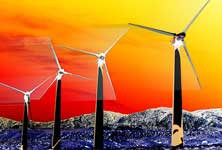Particle Systems are used to model situations where there are lots of identical objects each following different paths, or under the influence of different rules:
examples are:
- Water spray
- Flocks and Swarms
- Fog - Sunset
Water Spray
In this case each droplet of water is moving under the influence of Newtonian physics, being accelerated down by gravity, and moving away from the source of water due to its momentum.
Such systems may allow, force fields, sources and sinks of particles to be defined.
Flocks and Swarms
With animals, birds and insects, there will be other rules, in addition to the laws of physics, to interact with each other. For example, a flock of birds, will follow the leader and fly at a certain distance from each other, these rules will tend to cause certain patterns, such as birds flying in 'v' formation.
This requires a special type of particle system to model, which allows rules about preferred distances (inverse square law ??), speed limits, maximum acceleration, etc. to be specified. Also following behavior to be defined.
Other Uses of particles
This allows a node to be defined once, but during runtime multiple instances can be created of it each with different motion values.
Examples of the uses of this might be water flow, explosions, etc.
Since these are quite common, Liquid and Gas nodes can give a short cut to this capability. A Gas node can incorporate Fog.

